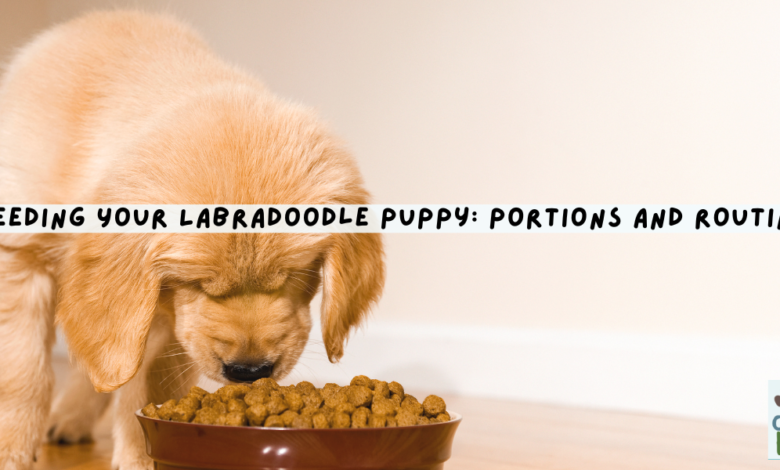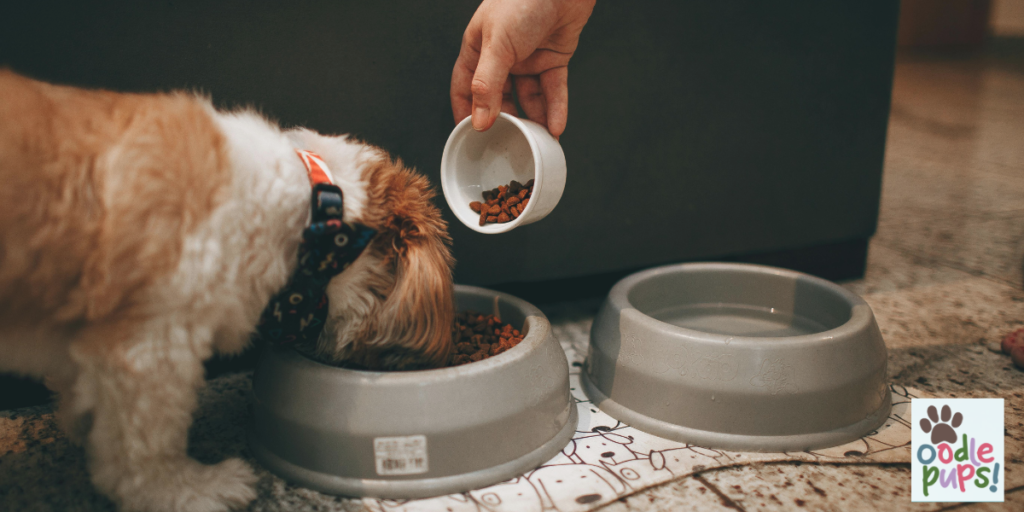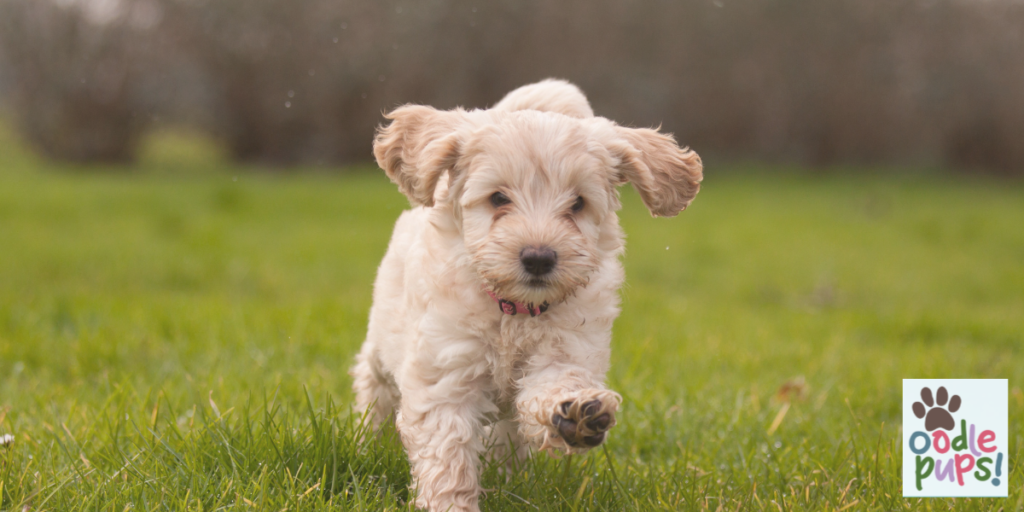Feeding Your Labradoodle Puppy: Portions and Routine

Are you wondering if you’re feeding your adorable new Labradoodle puppy the right amount?
Many new puppy parents feel the same, with breeders, vets, and online forums each giving their own advice.
At oodle pups, we’ve been supporting families for years with proper puppy care guidance. So we’re very familiar with your struggle.
In this Labradoodle feeding guide, you’ll get practical advice on portion sizes, daily feeding routines, and choosing the right puppy food for healthy growth.
Let’s start with the right daily portions for your puppy.
How Much Food Does a Labradoodle Puppy Need Daily?
Figuring out the right amount of food for your puppy can feel overwhelming at first. Fortunately, most growing puppies follow similar patterns, which makes it easier to get their portions just right. But the amount still varies based on your pup’s age, size, and activity level.

Here’s how you can determine the right portions for your Labradoodle.
Puppy portions by age
Your Labradoodle puppy’s stomach grows as they do, so portions increase over time. If you get the portions right, it helps your puppy grow properly without any health issues.
Let’s look at what works for most growing puppies at each stage:
- 8-12 weeks: Start with about ½ to ¾ cup per meal, given three to four times a day. At this stage, softening the puppy food with warm water makes it easier for your Labradoodle to digest. In total, they’ll eat around 1½ to 3 cups daily.
- 3-6 months: As your puppy grows, increase each meal to ¾ to 1 cup, served three times a day. By now, most puppies can handle dry food without any issues. The total daily amount usually falls between 2¼ and 3 cups.
- 6-12 months: Gradually switch to 1 to 1½ cups per meal, offered twice a day. Large breed puppies need steady, balanced nutrition during this period to support healthy growth. Overall, your pup will consume about 2 to 3 cups daily.
Remember that these amounts are only a guideline. You need to keep an eye on their weight and energy, and change portions when necessary.
See also: Understanding Real Estate Market Analysis Techniques
Feeding frequency and schedule
Your puppy needs to eat often since their little stomach can’t hold much at once. Because of this, sticking to a good feeding schedule keeps their energy steady and stops their blood sugar from dropping.
- 8-12 weeks: When your pup is really young, they should eat three to four times throughout the day. This frequent feeding helps them grow properly and keeps their tummies happy.
- 3-6 months: Around 3-6 months old is when you can move your puppy to three meals a day. Most families find that morning, afternoon, and evening feedings work well with their schedule.
- 6-12 months: Once your puppy hits 6 months or older, twice-daily feeding is perfect. By this point, their growth has slowed down, and their stomach can handle larger meals.
Now, one thing you want to avoid is free feeding, as it can cause weight gain and make house training harder.
Factors that influence how much to feed
Even with these guidelines, every puppy is different. Standard feeding charts give you a starting point, but several factors affect how much your specific pup actually needs.
Watch for these main influences on your puppy’s calorie intake:
- Activity Level: Your puppy’s activity affects how much food they need. That means playful, energetic pups will need more food than calmer ones. In a way, they’re like teen athletes who always seem hungry.
- Growth Spurts: Puppies sometimes have sudden growth spurts that make them extra hungry for a short time. But after a week or two, their appetite usually goes back to normal.
- Body Condition Overweight: Finally,we find it better to check your puppy’s body than the scale. You can do this by gently feeling their ribs without seeing them. From above, you should see a clear waist behind their ribs, which shows they are a healthy weight.
Once you’ve got the portions figured out, what type of food should actually go in that bowl?
Choosing the Right Dog Food: Dry, Wet, or Both?
The type of food you choose influences areas from your puppy’s teeth to their appetite. Each option has specific benefits that work better for different situations and preferences.

Compare each of these types to decide what works best for your growing puppy.
Dry dog food benefits
Dry food is probably what most people think of when they picture dog food. Those crunchy little pieces offer some real advantages that make life easier for both you and your puppy.
This is why so many families go with dry dog food for their puppies:
- Easy Portion Control: Kibble (small, dry pieces of dog food) makes it simple to control your puppy’s portions because you can measure each meal precisely. Unlike wet food, it won’t spoil if left out for a while, which also makes it handy for using as training treats throughout the day.
- Dental Benefits: Chewing dry food helps keep your puppy’s teeth a little cleaner. While it won’t replace regular brushing, the crunching motion removes some plaque that soft foods don’t.
- Training and Convenience: Dry food also works perfectly as small rewards during training sessions, making your life easier. It’s more affordable than wet food and can be stored without worrying about refrigeration.
While dry food offers many benefits, you still need to watch your puppy’s weight and eating habits.
Wet food pros and cons
Wet food is often a hit with puppies because it smells amazing and feels soft on their developing teeth. However, there are some trade-offs you should know about before making your decision.
Picky eaters usually love wet food because it has that strong, appetising smell and richer taste that kibble just can’t match. The extra moisture in wet food also helps keep your puppy hydrated, which is especially helpful if they’re not great at drinking enough water on their own.
Unfortunately, there’s a risk of overfeeding and the mess that comes with wet food. It’s much trickier to measure exact portions, and it’s easy to give too much without realising it. Plus, once you open a can or pouch, the food goes bad quickly, and cleanup around the feeding area becomes more of a chore.
Mixed feeding tips: Watch calories carefully to avoid overfeeding your puppy. Start with mostly dry food and add a small amount of wet food, adjusting portions based on your vet’s recommended calorie needs.
Ingredients to look for (and avoid)
Reading food labels may seem boring, but it’s one of the best ways to ensure your puppy gets the best nutrition for healthy growth. Look out for these ingredients when picking your puppy’s food.
- High-quality proteins: The first ingredient on your puppy’s food should be a real protein like chicken, beef, or fish. Without this, your puppy may not get the nutrients they need, so avoid foods that list vague items like “mystery meat.”
- Include Important Nutrients: Your puppy’s food should also have DHA from fish oil. It helps their brain and eyes develop properly.
- Avoid Fillers and Wrong Formulas: Lastly, stay away from “all life stages” foods since they may not give puppies what they need. We also recommend avoiding foods where corn, wheat, or soy are the main ingredients, since these are mostly cheap fillers.
After selecting foods with the right ingredients, make it a habit to check your puppy’s growth, energy, and health.
Feed Your Puppy Right
Do you feel less overwhelmed about raising your puppy now? With these feeding guidelines, you’re well-equipped to give your Labradoodle the best start in life.
We usually recommend keeping a simple feeding routine: give meals at 7 am, 12 pm, and 6 pm until your puppy turns six months, then move to just 7 am and 6 pm.
Also, here’s an important reminder: Labradoodles can develop food sensitivities. Their Labrador traits may cause allergies, and their Poodle traits may react to beef, dairy, or wheat. These usually appear between 1-3 years old.
If you want to learn more about raising your Labradoodle, the team at Oodle Pups is always here to give friendly, expert advice whenever you need it.
